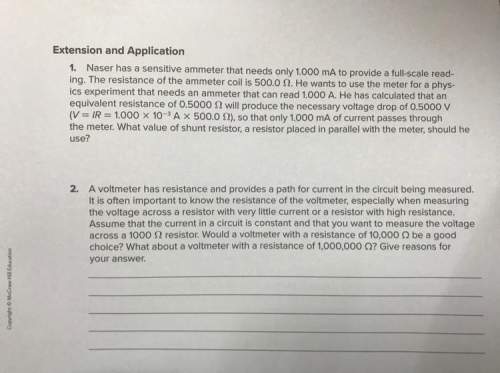Two vectors with magnitudes of 4 meters and 3 meters cannot have a resultant of
a. 3 meters
b...

Physics, 30.07.2020 04:01 izabelllreyes
Two vectors with magnitudes of 4 meters and 3 meters cannot have a resultant of
a. 3 meters
b. 4 meters
c. 07 meters
d. 8 meters

Answers: 1


Another question on Physics

Physics, 21.06.2019 17:50
The slotted link is pinned at o, and as a result of rotation it drives the peg p along the horizontal guide. compute the magnitude of the velocity and acceleration of p along the horizontal guide. compute the magnitudes of the velocity and acceleration of p as a function of θ if θ=(3t) rad, where t is measured in seconds.
Answers: 1

Physics, 21.06.2019 20:50
Aball is thrown upward in the air, and its height above the ground after t seconds is h ( t ) = 57 t − 16 t 2 feet. find the time t when the ball will be traveling upward at 14.25 feet per second.
Answers: 1

Physics, 21.06.2019 21:40
This problem has been solved! see the answera non-uniform fire escape ladder is 6.0m long whenextended to the icy alley below. it is held at the top by africtionless pivot, and there is neglibible frictional force fromthe icy surface at the bottom. the ladder weighs 250n, and it'scenter of gravity is 2.0m along the ladder from the bottom. amother and child of total weight 750n are on the ladder 1.5m fromthe pivot. the ladder makes an angle θ with the horizontal.find the magnitude and direction ofa) the force exerted by the icy alley on the ladderb) the force exerted by the ladder on the pivotc) do your answers in part a and b depend on the angle?
Answers: 3

Physics, 21.06.2019 22:50
A23 kg log of wood begins from rest, 300 m up a sluice (a water track used to transport logs, think of it as an inclined plane with negligible friction) inclined at 20° to the horizontal. after it reaches the flat waterway at the bottom it collides elastically with a 100 kg block of wood initially at rest near the base of the incline. (a) how long does it take the 23 kg log to travel down the incline? (b) what is the speed of the 23 kg log at the bottom of the incline? (c) what are the velocities of both blocks of wood after the collision? (d) what is the total kinetic energy before the collision? (e) what is the kinetic energy of the 23 kg log after the collision? (f) what is the kinetic energy of the 100 kg block of wood after the collision? (g) what is the total kinetic energy after the collision? (h) compare the total initial and total final kinetic energies. is this consistent with what you would expect for elastic collisions? explain!
Answers: 1
You know the right answer?
Questions





Spanish, 19.05.2020 17:57


Mathematics, 19.05.2020 17:57


Mathematics, 19.05.2020 17:57

English, 19.05.2020 17:57



Mathematics, 19.05.2020 17:57





English, 19.05.2020 17:57





